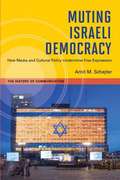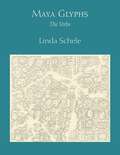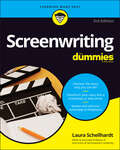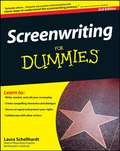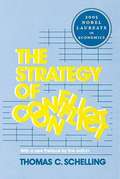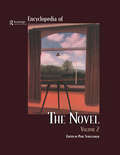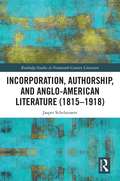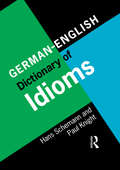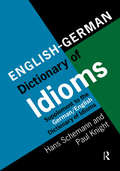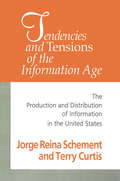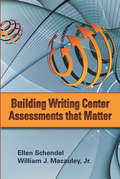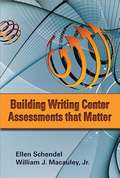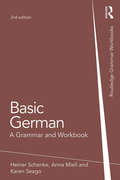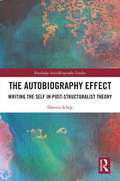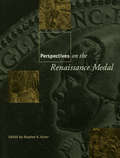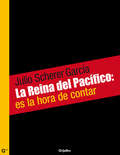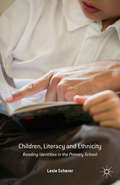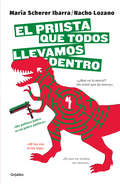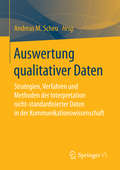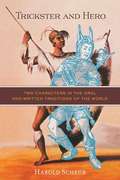- Table View
- List View
Muting Israeli Democracy: How Media and Cultural Policy Undermine Free Expression
by Amit M. SchejterThe result of years of critical analysis of Israeli media law, this book argues that the laws governing Israeli electronic media are structured to limit the boundaries of public discourse. Amit M. Schejter posits the theory of a "mute democracy," one in which the media are designed to provide a platform for some voices to be heard over others. While Israel's institutions may be democratic, and while the effect of these policies may be limited, this book contends that free speech in Israel is institutionally muted to ensure the continued domination of the Jewish majority and its preferred interpretation of what Israel means as a Jewish-democratic state. Analyzing a wide range of legal documents recorded in Israel from 1961 to 2007, Muting Israeli Democracy demonstrates in scrupulous detail how law and policy are used to promote the hegemonic national culture through the constraints and obligations set on electronic media.
Maya Glyphs: The Verbs
by Linda ScheleThe key to the study of the language and history of the Classic Maya (A. D. 293-900) is the verb. Maya Glyphs: The Verbs is a comprehensive study of the verb morphology and syntax of the Maya writing system. Linda Schele's summary of methodology makes available in a single place many important discoveries and approaches to the Maya language. Hers is the first sourcebook to include so broad a range of dates and to identify for the first time so many Maya rulers and events. The admirably lucid text provides an excellent introduction to Maya hieroglyphics for the beginner, and, for the experienced Mayanist, it offers a fascinating explanation of methodology, including paraphrasing, and important information about syntactical structures, special verbal constructions, and literary conventions. Schele's extensive catalog of known verbal phrases is useful for a variety of purposes. Because it is organized according to verbal affix patterns, it provides the only available source for the distribution of such patterns in the writing system. At the same time it registers the date of each event, its agent and patient (if recorded), the dedication date of the monument on which the glyphs occur, and a pictorial illustration, rather than a T-number transcription, of each example. Extensive notes treating problems of dating, interpretation, and dynastic information contain theories about the meaning and function of the events recorded in the Maya inscriptions. The key to the study of the language and history of the Classic Maya (A. D. 293-900) is the verb. Maya Glyphs: The Verbs is a comprehensive study of the verb morphology and syntax of the Maya writing system. Linda Schele's summary of methodology makes available in a single place many important discoveries and approaches to the Maya language. Hers is the first sourcebook to include so broad a range of dates and to identify for the first time so many Maya rulers and events. The admirably lucid text provides an excellent introduction to Maya hieroglyphics for the beginner, and, for the experienced Mayanist, it offers a fascinating explanation of methodology, including paraphrasing, and important information about syntactical structures, special verbal constructions, and literary conventions. Schele's extensive catalog of known verbal phrases is useful for a variety of purposes. Because it is organized according to verbal affix patterns, it provides the only available source for the distribution of such patterns in the writing system. At the same time it registers the date of each event, its agent and patient (if recorded), the dedication date of the monument on which the glyphs occur, and a pictorial illustration, rather than a T-number transcription, of each example. Extensive notes treating problems of dating, interpretation, and dynastic information contain theories about the meaning and function of the events recorded in the Maya inscriptions.
Literary Coteries and the Making of Modern Print Culture
by Betty A. SchellenbergLiterary Coteries and the Making of Modern Print Culture offers the first study of manuscript-producing coteries as an integral element of eighteenth-century Britain's literary culture. As a corrective to literary histories assuming that the dominance of print meant the demise of a vital scribal culture, the book profiles four interrelated and influential coteries, focusing on each group's deployment of traditional scribal practices, on key individuals who served as bridges between networks, and on the aesthetic and cultural work performed by the group. The book also explores points of intersection between coteries and the print trade, whether in the form of individuals who straddled the two cultures; publishing events in which the two media regimes collaborated or came into conflict; literary conventions adapted from manuscript practice to serve the ends of print; or simply poetry hand-copied from magazines. Together, these instances demonstrate how scribal modes shaped modern literary production. This title is also available as Open Access.
The Professionalization of Women Writers in Eighteenth-Century Britain
by Betty A. SchellenbergThe Professionalisation of Women Writers in Eighteenth Century Britain is a full study of a group of women who were actively and ambitiously engaged in a range of innovative publications at the height of the eighteenth century. Using personal correspondence, records of contemporary reception, research into contemporary print culture and sociological models of professionalisation, Betty A. Schellenberg challenges oversimplified assumptions of women's cultural role in the period, focusing on those women who have been most obscured by literary history, including Frances Sheridan, Frances Brooke, Sarah Fielding and Charlotte Lennox.
Samuel Richardson
by Betty A. SchellenbergSamuel Richardson (1689-1761) was a highly regarded printer and influential novelist when he produced his final work of fiction, The History of Sir Charles Grandison (1753). Like his other novels, it was written in epistolary form, reflecting his lifelong interest in letter writing and the letter as a genre. Covering the period 1750-1754, many of these fully annotated letters are published from manuscript for the first time, or have been restored to their complete original form. Recording Richardson's relationships with leading cultural figures including Samuel Johnson, Colley Cibber and Elizabeth Carter, the volume reveals his support for other authors while struggling to complete his own 'story of a Good Man'. This publishing saga also incorporates Richardson's responses to the Irish piracy of his novel, and his exchanges with anonymous fans, including those who attacked the novel's tolerance for Catholicism and those who pleaded for a sequel.
Screenwriting For Dummies
by Laura SchellhardtSuspend your disbelief—you can make it as a screenwriter Behind every blockbuster film and binge-worthy show, there’s a screenwriter—and that writer could be you! Turn your brainstorming sessions into dynamic scripts with the help of Screenwriting For Dummies. Create believable worlds with relatable characters, gripping dialogue, and narrative structures that will keep even the showbiz bigwigs on the edge of their seats. Once you’ve polished your product, it’s time to bring it to market. This book is full of advice that will help you get eyes on your screenplays so you can sell your work and find success as a screenwriter. From web series to movie musicals to feature films, this book shows you how to develop and hone your craft. Learn to think like a screenwriter and turn story ideas into visually driven, relatable scripts that will get noticed Study the elements of a story, like plot structure (beginning, middle, and end) and characterization (wait, who’s that, again?) Hop over the hurdle of writer’s block, and tackle other obstacles that stand in the way of your scriptwriting career Get insider insight into finding an agent and meeting with studio execs, plus alternative markets for your finished work This updated edition covers the latest trends and opportunities—and there are lots of them—for today’s writers. Let Dummies help you map out your story and put your script on the road to production. Thank us when your work goes viral!
Screenwriting For Dummies, 2nd Edition
by Laura Schellhardt John LoganWrite a great script and get it into the hands of the Hollywood players! So you want to be a screenwriter? Whether you want to write a feature film or a TV script or adapt your favorite book, this friendly guide gives you expert advice in everything from creating your story and developing memorable characters to formatting your script and selling it to the studios. You get savvy industry tips and strategies for getting your screenplay noticed! The screenwriting process from A to Z -- from developing a concept and thinking visually to plotline, conflicts, pacing, and the conclusion Craft living, breathing characters -- from creating the backstory to letting your characters speak to balancing dialogue with action Turn your story into a script -- from developing an outline and getting over writer's block to formatting your screenplay and handling rewrites Prepare for Hollywood -- from understanding the players and setting your expectations to polishing your copy and protecting your work Sell your script to the industry -- from preparing your pitch and finding an agent to meeting with executives and making a deal Open the book and find: The latest on the biz, from entertainment blogs to top agents to box office jargon New story examples from recently released films Tips on character development, a story's time clock, dramatic structure, and dialogue New details on developing the nontraditional screenplay -- from musicals to animation to high dramatic style Expanded information on adaptation and collaboration, with examples from successful screenwriting duos
The Strategy of Conflict
by Thomas C. SchellingThe text opens to rational analysis a crucial field of politics, the international politics of threat, or as the current term goes, of deterrence.
Encyclopedia of the Novel
by Paul Schellinger Christopher Hudson Marijke RijsbermanThe Encyclopedia of the Novel is the first reference book that focuses on the development of the novel throughout the world. Entries on individual writers assess the place of that writer within the development of the novel form, explaining why and in exactly what ways that writer is importnant. Similarly, an entry on an individual novel discusses the importance of that novel not only form, analyzing the particular innovations that novel has introduced and the ways in which it has influenced the subsequent course of the genre. A wide range of topic entries explore the history, criticism, theory, production, dissemination and reception of the novel. A very important component of the Encyclopedia of the Novel is its long surveys of development of the novel in various regions of the world.
Incorporation, Authorship, and Anglo-American Literature (Routledge Studies in Nineteenth Century Literature)
by Jasper SchelstraeteIncorporation, Authorship, and Anglo-American Literature (1815–1918) is concerned with the new ways in which nineteenth-century authors came to imagine nationhood in response to the emergent global market. It investigates how authors negotiated a largely unregulated global economic space, both imaginatively—in their representations of it—and pragmatically, through author-publisher agreements to circumvent the lack of transnational copyright or through market-driven self-censorship for different audiences. Until now, scholarship has struggled to find a single dynamic from which to consider the Anglo-American transatlantic cultural field, and transnational fields more generally. This volume offers that single dynamic through an innovative and interdisciplinary approach that brings together the research areas of literary and transnational studies with economic history. It shows how the positional national identities constructed by nineteenth-century texts were informed by economic self-interest in the emergent global marketplace. Through a series of case studies the book analyses how contemporary economic innovations determined nineteenth-century concepts of national and cultural self-identification. Presented within four main body chapters, each considers two case studies of nineteenth-century authors that are in productive contrast, including pairings between Herman Melville and Washington Irving, E.D.E.N. Southworth and Anthony Trollope, Charles Dickens and Harriet Beecher Stowe, and finally Thomas Hardy and Joseph Conrad.
German/English Dictionary of Idioms: Supplement To The German/english Dictionary Of Idioms
by Hans SchemannThis unique dictionary covers all the major German idioms and is probably the richest source of contemporary German idioms available, with 33,000 headwords. Within each entry the user is provided with: English equivalents; variants; contexts and precise guidance on the degree of currency/rarity of an idiomatic expression. This dictionary is an essential reference for achieving fluency in the language. It will be invaluable for all serious learners and users of German. Not for sale in Germany, Austria and Switzerland.
English/German Dictionary of Idioms: Supplement to the German/English Dictionary of Idioms
by Professor Hans SchemannThis dictionary is the ideal supplement to the German/English Dictionary of Idioms, which together give a rich source of material for the translator from and into each language. The dictionary contains 15,000 headwords, each entry supplying the German equivalents, variants, contexts and the degree of currency/rarity of the idiomatic expression. This dictionary will be an invaluable resource for students and professional literary translators.Not for sale in Germany, Austria or Switzerland
Sociolinguistics and Deaf Communities
by Adam C. Schembri Ceil LucasHow do people use sign languages in different situations around the world? How are sign languages distributed globally? What happens when they come in contact with spoken and written languages? These and other questions are explored in this new introduction to the sociolinguistics of sign languages and deaf communities. An international team brings insights and data from a wide range of sign languages, from the USA, Canada, England, Spain, Brazil and Australia. Topics covered include multilingualism in the global deaf community, sociolinguistic variation and change in sign languages, bilingualism and language contact between signed and spoken languages, attitudes towards sign languages, sign language planning and policy, and sign language discourse. Sociolinguistics and Deaf Communities will be welcomed by students of sign language and interpreting, teachers of sign language, and students and academics working in linguistics.
Tendencies and Tensions of the Information Age: Production and Distribution of Information in the United States
by Jorge Reina Schement Terry CurtisThe development of technology and the hunger for information has caused a wave of change in daily life in America. Nearly every American's environment now consists of cable television, video cassette players, answering machines, fax machines, and personal computers. Schement and Curtis argue that the information age has evolved gradually throughout the twentieth century. National focus on the production and distribution of information stems directly from the organizing principles and realities of the market system, not from a revolution sparked by the invention of the computer.Now available in paperback, Tendencies and Tensions of the Information Age, brings together findings from many disciplines, including classical studies, etymology, political sociology, and macroeconomics. This valuable resource will be enjoyed by sociologists, historians, and scholars of communication and information studies.
Building Writing Center Assessments That Matter
by Ellen Schendel William J. MacauleyNo less than other divisions of the college or university, contemporary writing centers find themselves within a galaxy of competing questions and demands that relate to assessment—questions and demands that usually embed priorities from outside the purview of the writing center itself. Writing centers are used to certain kinds of assessment, both quantitative and qualitative, but are often unprepared to address larger institutional or societal issues. In Building Writing Center Assessments that Matter, Schendel and Macauley start from the kinds of assessment strengths already in place in writing centers, and they build a framework that can help writing centers satisfy local needs and put them in useful dialogue with the larger needs of their institutions, while staying rooted in writing assessment theory. The authors begin from the position that tutoring writers is already an assessment activity, and that good assessment practice (rooted in the work of Adler-Kassner, O'Neill, Moore, and Huot) already reflects the values of writing center theory and practice. They offer examples of assessments developed in local contexts, and of how assessment data built within those contexts can powerfully inform decisions and shape the futures of local writing centers. With additional contributions by Neal Lerner, Brian Huot and Nicole Caswell, and with a strong commitment to honoring on-site local needs, the volume does not advocate a one-size-fits-all answer. But, like the modeling often used in a writing consultation, examples here illustrate how important assessment principles have been applied in a range of local contexts. Ultimately, Building Writing Assessments that Matter describes a theory stance toward assessment for writing centers that honors the uniqueness of the writing center context, and examples of assessment in action that are concrete, manageable, portable, and adaptable.
Building Writing Center Assessments That Matter
by Ellen Schendel William J. MacauleyNo less than other divisions of the college or university, contemporary writing centers find themselves within a galaxy of competing questions and demands that relate to assessment--questions and demands that usually embed priorities from outside the purview of the writing center itself. Writing centers are used to certain kinds of assessment, both quantitative and qualitative, but are often unprepared to address larger institutional or societal issues. In Building Writing Center Assessments that Matter, Schendel and Macauley start from the kinds of assessment strengths already in place in writing centers, and they build a framework that can help writing centers satisfy local needs and put them in useful dialogue with the larger needs of their institutions, while staying rooted in writing assessment theory.The authors begin from the position that tutoring writers is already an assessment activity, and that good assessment practice (rooted in the work of Adler-Kassner, O'Neill, Moore, and Huot) already reflects the values of writing center theory and practice. They offer examples of assessments developed in local contexts, and of how assessment data built within those contexts can powerfully inform decisions and shape the futures of local writing centers. With additional contributions by Neal Lerner, Brian Huot and Nicole Caswell, and with a strong commitment to honoring on-site local needs, the volume does not advocate a one-size-fits-all answer. But, like the modeling often used in a writing consultation, examples here illustrate how important assessment principles have been applied in a range of local contexts. Ultimately, Building Writing Assessments that Matter describes a theory stance toward assessment for writing centers that honors the uniqueness of the writing center context, and examples of assessment in action that are concrete, manageable, portable, and adaptable.
Basic German: A Grammar and Workbook (Routledge Grammar Workbooks)
by Heiner Schenke Anna Miell Karen SeagoBasic German: A Grammar and Workbook comprises an accessible reference grammar and related exercises in a single volume. The book introduces German people and culture through the medium of the language used today, covering the core material which students would expect to encounter in their first years of learning German. Each of the 29 units presents one or more related grammar topics, illustrated by examples which serve as models for the exercises that follow. These wide-ranging and varied exercises enable the student to master each grammar point thoroughly. Features include: • Clear grammatical explanations with examples in both English and German • Authentic language samples from a range of media • Checklists at the end of each unit to reinforce key points • Cross-referencing to other grammar chapters • Full exercise answer key • ‘Did you know?’ sections with extra learning tips on specific grammar points and insights into current usage of German • Glossary of grammatical terms The new edition has been thoroughly revised, including more varied exercises for practice, and grammar points have been reformulated to use a more learner-centred approach. Suitable for independent study and for class use, Basic German: A Grammar and Workbook is the ideal reference and practice book for beginners, as well as for students with some knowledge of the language. ?
The Autobiography Effect: Writing the Self in Post-Structuralist Theory (Routledge Auto/Biography Studies)
by Dennis SchepSince the advent of post-structuralism, various authors have problematized the modern conception of autobiography by questioning the status of authorship and interrogating the relation between language and reality. Yet even after making autobiography into a theoretical problem, many of these authors ended up writing about themselves. This paradox stands at the center of this wide-ranging study of the form and function of autobiography in the work of authors who have distanced themselves from its modern instantiation. Discussing Roland Barthes, Jacques Derrida, Hélène Cixous and others, this book grapples with the question of what it means to write the self when the self is understood as an effect of writing. Combining close reading, intellectual history and literary theory, The Autobiography Effect traces how precisely its theoretically problematic nature made autobiography into a central scene for the negotiation of philosophical positions and anxieties after structuralism.
Perspectives on the Renaissance Medal: Portrait Medals of the Renaissance (Garland Studies in the Renaissance #9)
by Stephen K. ScherThe papers published in this book were delivered at two conferences held in conjunction with the exhibition, " The Currency of Fame: Portrait Medals of the Renaissance"
Octavio Paz: una vuelta a su vida
by Julio Scherer GarcíaUn libro para conocer las facetas de Octavio Paz a través de las conversaciones con Julio Scherer. Aquel 18 de octubre de 1993, Julio Scherer conversó con el mayor de los intelectuales mexicanos, Octavio Paz, con quien además de entablar una sincera amistad, compartió la preocupación por analizar y esclarecer los problemas del país. Scherer, una vez más haciendo gala de sus grandes dotes periodísticas, cuestionó al ganador del premio Nobel sobre temas como el 68 y los movimientos estudiantiles de esa época, la sucesión presidencial, la evolución política de México y la democracia, entre otros. Este intercambio, además, evoca la hostilidad gubernamental e intelectual que Paz vivió tras dejar la embajada de México en la India: "Me pides un juicio sobre la vida de México y sobre la mía propia, desde 1971 hasta nuestros días... más de veinte años ricos en cambios y peripecias", comenta el poeta y escritor mexicano.
La reina del pacífico: es la hora de contar
by Julio Scherer GarcíaUn extraordinario reportaje que muestra a la mujer-mito del narco mexicano tal cual es: explicando lo que significa nacer, crecer y vivir en ese mundo, contando sus experiencias con los grandes capos y los narcopolicías, revelando las entrañas de ese infierno y también su intimidad... todo ello gracias al enorme oficio del mejor periodista de México. Resultado de una larga serie de entrevistas a Sandra Ávila, la Reina del Pacífico, contiene el primer testimonio sobre lo que significa nacer, crecer y vivir dentro de la mafia del narcotráfico. Esta mujer-mito le platica a Julio Scherer su historia, en la cual se manifiesta directamente, con todas sus contradicciones, temores y arrebatos. Su voz, ante el periodista y la opinión pública, retumba poderosa, aunque por momentos se exprese a la defensiva, lacónica y desalentada. Gracias al enorme oficio narrativo de quien es considerado el mejor periodista de México, Sandra Ávila nos presenta las entrañas de ese mundo gobernado por la muerte, pero también habla de su intimidad. "Y en la lucha por mostrarse dueña de sí misma" -como escribe Scherer-, resulta contundente. "Me he emborrachado con la vida y he padecido crudas de las que me he levantado. Ahora tropiezo con los muros de mi celda entre la depresión y el ánimo, medio muerta y medio viva, caída y vuelta a levantar..." Libro único en muchos sentidos, La Reina del Pacífico: Es la hora de contar se publica en el momento más trascendental de la guerra contra el narcotráfico. Suministra a los lectores piezas cardinales que le permiten descifrar el rompecabezas de esta violencia sin antecedentes que sufre nuestro país y que parece no tener fin.
Children, Literacy and Ethnicity: Reading Identities in the Primary School
by Lexie SchererThis book explores children's meaning making of the books they learn to read with, especially relating to the intersections of race, gender and class. Based on research using a participative, innovative design with young children, issues of identity, belonging and classroom hierarchies are explored in complex and poignant ways by the children.
El priista que todos llevamos dentro
by María Scherer Nacho LozanoCómico y trágico a la vez, El priista que llevamos dentro recuerda una sentencia que se ha tratado en más de un discurso, incluso por quienes niegan la cruz de su parroquia: ¿tenemos un priista interior?María Scherer Ibarra y Nacho Lozano, destacados periodistas de la fuente política, comparten en este libro una reflexión para todos los tiempos y el resultado de desenmascarar un rasgo que nos afecta a todos. Si la modernidad en México nació con el final de la Revolución , sería prudente pensar que heredamos algo de aquellos que nos formaron. Pero queda pendiente una pregunta después de toda una historia sin demasiados cambios: ¿tenemos una huella genética que se dejó alcanzar por una cultura priista? Una conclusión es segura: todo cabe en un priista sabiéndolo acomodar."¿Qué es la moral? Un árbol que da moras""Un político pobre es un pobre político""Ni los veo ni los oigo""El que no transa no avanza"
Auswertung qualitativer Daten: Strategien, Verfahren und Methoden der Interpretation nicht-standardisierter Daten in der Kommunikationswissenschaft
by Andreas M. ScheuDer Band bietet einen #65533;berblick #65533;ber qualitative Auswertungsverfahren und -strategien im Fach Kommunikationswissenschaft. Die Beitr#65533;ge besch#65533;ftigen sich mit der Auswertung unterschiedlichen Datenmaterials (z. B. Interviews, Gruppendiskussionen, audiovisuelle Daten), mit forschungspraktischen Herausforderungen in Quer- und L#65533;ngsschnittstudien, mit unterschiedlichen Strategien der Datenauswertung (z. B. Typologien, Cluster, Vergleiche, Diskursanalysen, Netzwerkanalysen) sowie verschiedenen qualitativen Perspektiven; von eher induktiven Auswertungsstrategien #65533;ber deduktive, theoriegeleitete Verfahren bis hin zu teilweise automatisierten Prozessen.
Trickster and Hero
by Harold ScheubThe trickster and the hero, found in so many of the world’s oral traditions, are seemingly opposed but often united in one character. Trickster and Heroprovides a comparative look at a rich array of world oral traditions, folktales, mythologies, and literatures—fromThe Odyssey,The Epic of Gilgamesh, andBeowulfto Native American and African tales. Award-winning folklorist Harold Scheub explores the “Trickster moment,” the moment in the story when the tale, the teller, and the listener are transformed: we are both man and woman, god and human, hero and villain. Scheub delves into the importance of trickster mythologies and the shifting relationships between tricksters and heroes. He examines protagonists that figure centrally in a wide range of oral narrative traditions, showing that the true hero is always to some extent a trickster as well. The trickster and hero, Scheub contends, are at the core of storytelling, and all the possibilities of life are there: we are taken apart and rebuilt, dismembered and reborn, defeated and renewed.
